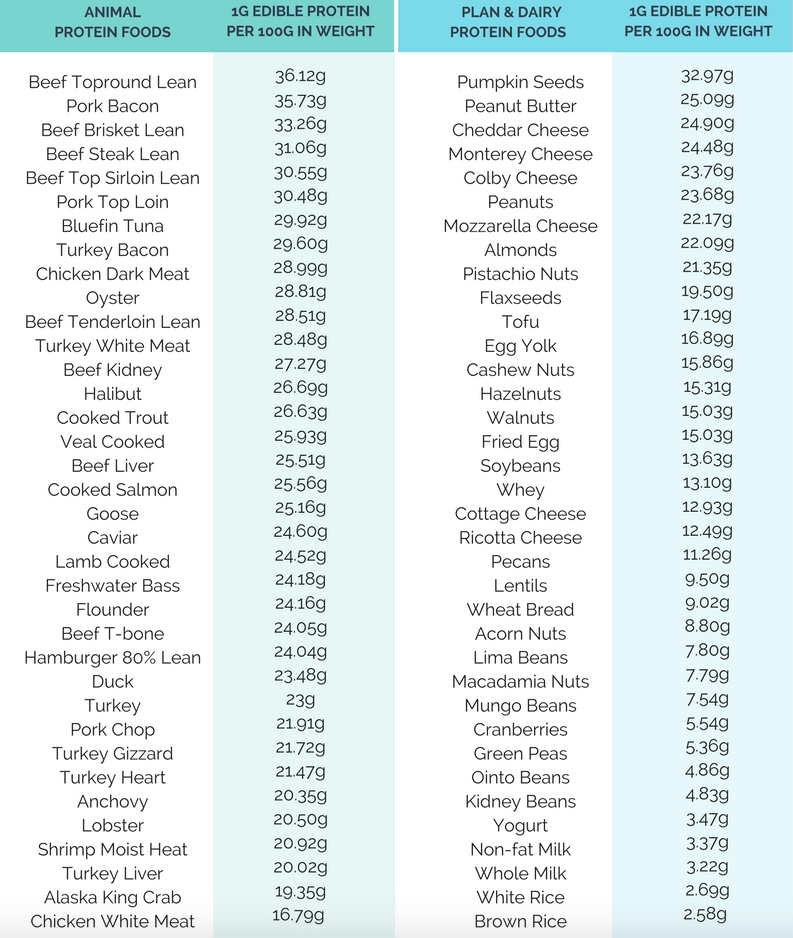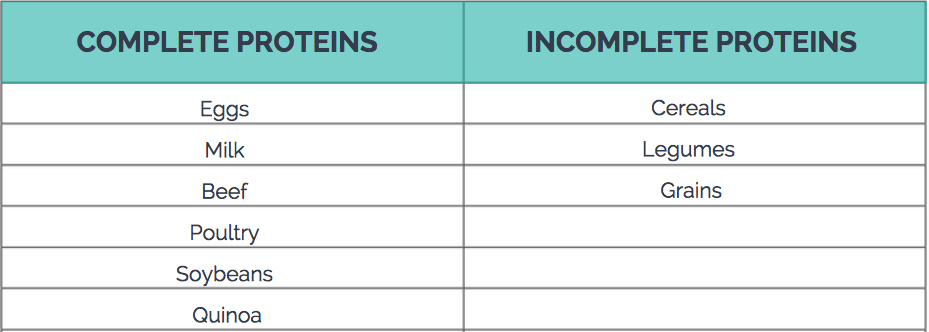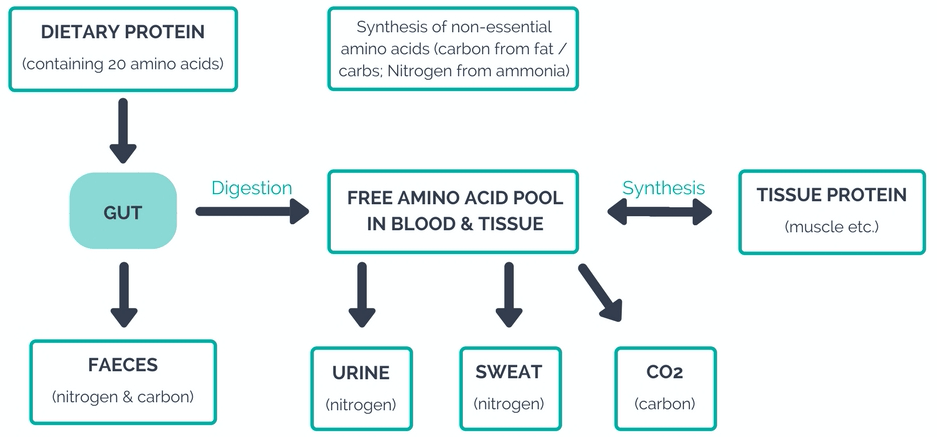The macronutrients are protein, fats and carbohydrates, with ‘macro’ being given to the term as these nutrients make up the majority of energy obtained from our daily diet.
This article will show you what is protein and how much protein do we need. It will provide you with a full understanding of this macronutrient.
Before digging in, as a valued reader of the blog, I’d like to extend you an invitation to our upcoming and totally FREE online training workshop:
‘The Proven Nutrition Strategies of Elite Trainers’.
This workshop is for you if you want to finally learn the best nutrition protocols and evidenced-based strategies to help your clients achieve life-changing results.
This workshop is our most complete training on how to make nutrition coaching easy and profitable.
All you need to do to attend is click here to register your free spot.

What is Protein
Protein is incredibly important, and without it our body composition and health greatly suffer as a result.
Proteins are an essential nutrient and can be broken down into 20 building blocks known as amino acids. Out of these 20 amino acids, 9 are considered to be essential as the body cannot synthesize its own, meaning we must obtain these from animal and plant sources. The other 11 aminos can be synthesized by the body, making them non-essential.
The table below shows how protein can be broken down into its essential and non-essential amino acids.

*Branched-chain amino acids
**Conditionally essential amino acids
Within the 9 essential amino acids, there are 3 branch chain amino acids (BCAA’s): leucine, isoleucine and valine which are again different to the others as they do not require metabolizing by the liver, and are therefore taken up directly by skeletal muscle.
Also, these 3 aminos are the most important for the manufacture, maintenance and repair of muscle tissue.
Of the three, leucine has shown to be the most effective amino at stimulating protein synthesis (the process of building muscle protein and therefore growth), yet the three work better together to provide a host of benefits and even boost energy during workouts. (1) (2)
Studies show that BCAA supplementation alone can blunt the catabolic hormone cortisol and decrease delayed-onset muscle soreness. (3)
Below is a table that shows the protein quantity in many of the common foods we eat:

Protein Quality
When considering a protein source or determining its amino acid profile values, one of the most popular methods is to classify the food by its biological value (BV).
The biological value of a protein is based on its quantity of the essential amino acids. So a food with a high BV (also known as a complete protein) contains all 9 essential aminos. This is commonly seen in animal and dairy products.
A food with low to medium BV does not contain all of the essential amino acids. This is common in plant based protein sources, and it is only when these low BV foods are combined that you can create a higher quality BV in meals.
This alone is a key reason as to why animal proteins (meat & dairy) are so important in our diets.
Below is a table showing food sources that provide a complete and incomplete amino acid profile:

The Role of Protein
When we do consume sufficient amounts of high quality and complete proteins, it has a whole host of benefits.
The Functions of Body Proteins
Growth and Maintenance:
Regulatory Roles:
Energy Production:
Protein Metabolism
There are around 50,000 different protein-containing compounds in the body, and 65% of them are found in skeletal muscle.
When we ingest more protein then we excrete (typically lost from urine, faeces or converted to fat/cholesterol) we are known to be in a positive nitrogen balance.
This means we will have a high level of amino acids in our blood and body fluids. This process only occurs after regular protein intake. Before amino acids can enter the blood stream, protein must be digested in the stomach. This occurs when hydrochloric acid creates an active enzyme known as ‘pepsin’.
Structurally, proteins consist of various combinations of amino acids linked together by peptide bonds. Pepsin is the enzyme responsible for breaking down the peptide bonds to form smaller peptides and free form amino acids.
From here, the proteins are passed onto the small intestines, and are at this point finally digested to absorbable amino acids.
From here, the amino acids can enter the amino acid pool and will be used in a matter of two ways by the body:
- Protein synthesis will create new proteins for the body in terms of body tissue (muscle, liver, kidneys etc), hormones, enzymes and all the other previously mentioned functions of proteins. Enter your text here...
- Excreted by urine as urea (nitrogen containing organic compound), or converted to fat and/or cholesterol.
The table below summarizes this metabolic process:

How Much Protein Do We Need
The debate still continues on how much protein we need daily, but there appears to be a general agreement that active individuals need a higher intake than sedentary people.
The DRI (Dietary Reference Intake) suggests 0.8 grams of protein per kilogram of body weight, or 0.36 grams per pound. (4)
This means an intake for a man weighing 80kg is 64g. This means an intake for a woman weighing 60kg is 48g.
As you can see, this isn’t a lot of protein and we now know that for optimal body composition and health, we need a lot more.
It’s difficult to put an exact figure on how much protein everyone should really be consuming, as it all depends on their goals, activity levels, caloric intake, muscle mass, training schedule and current health.
Therefore we must resort to the research that can help us make the right decisions, yet it too seems to vary from source to source.
The average intake
For a healthy person of a healthy weight who is mainly sedentary and is not seeking changes in body composition – then an intake of 0.4 – 0.6 grams of protein per pound bodyweight is sufficient.
When losing body fat
Protein has a high thermic effect, meaning it boosts our metabolic rate in the process (we burn more calories) and reduces our appetites (we eat less calories). (5) (6)
This increase in metabolic effect has been shown to be most effective when protein is set to 25-30% of daily caloric intake. (7) (8)
Having a high protein intake during a calorie deficit is also important, as it is very anabolic, meaning we are more likely to preserve lean body tissue in the process. (9)
When building muscle
The key to building muscle is protein synthesis. A higher protein diet will up regulate protein synthesis (providing you have evenly spaced meals), which creates a net positive protein balance, resulting in that anabolic (building) environment. (10)
The studies that look at muscle mass and protein intake tend to vary from 0.8-1.0+ gram per pound bodyweight, so it’s safe to say a balanced approach would be most beneficial, so around 1g per pound bodyweight is highly effective. (11) (12)
Active and elderly
Body composition goals aside, you may find some clients are highly active, through their jobs or activities (such as endurance training).
The research shows a daily intake of 0.5-0.65 grams per pound bodyweight for these types of people. (13)
Elderly people can also benefit from more protein to help prevent aging diseases such as osteoporosis and sarcopenia (reduced muscle mass).
The research shows a daily intake of 0.45-0.6 gram per pound bodyweight. (14) Finally, those recovering from injuries may also benefit from a higher protein diet.
Timing & Type
We have already discussed that we assess the quality of our protein sources via the biological value, therefore the type of protein we ingest will improve the results we see.
We also know that animal proteins are better at improving strength and body composition compared to a plant based approach (vegetarian).
Also, proteins that contain high levels of BCAA’s, particularly leucine, will produce greater protein synthesis, improve insulin signaling and spare glucose in muscle cells.
Dangers of a High Protein Diet
Many people will try and tell us that a high protein diet is bad for us, and that it is linked to cardiovascular disease, dehydration, calcium loss and damaged liver and kidney function.
The question that must be asked is – show us the accurate research.
The small amount of research that may support these dangers appears - just like many things in the nutritional world - to have been greatly exaggerated.
Here’s what you need to know:
You should now understand the importance of protein in the human diet, how it is metabolized, how to measure quality, assess daily intake for various populations, compare protein types and de bunk some of the myths that surround it.
Become an elite-level nutrition coach
My team and I have just finished up creating a brand new online training workshop called 'The Proven Nutrition Strategies of Elite Trainers.'
Best part? It costs you nothing. This is your official invite - all you need to do to attend is click here to register.
This free nutrition course is for you if you want to finally learn the best nutrition protocols and evidenced-based strategies to help your clients achieve life-changing results.
Join me and I’ll walk you through the exact steps you need to take in order to get incredible client results, boost your confidence and build your business with proven nutrition coaching strategies.

